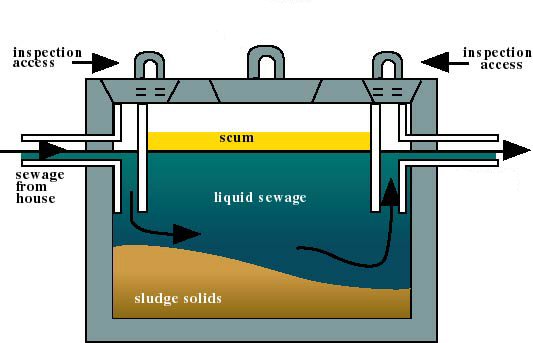(http://www.mitchellandmitchell.com/blog/septic_tanks_what_are_they_what_to_do_before_buying_a_home_with_one.aspx)
Why Treat Sewage ?
- Environmentally-safe fluid waste stream and a solid waste
suitable for disposal or reuse (usually as farm fertilizer).
- Using advanced technology it is now possible to re-use sewage
effluent for drinking water.
Sludge
- Residual, semi-solid material left from sewage treatment
processes or settled suspension from conventional drinking water treatment.
- Untreated sludge is a significant environmental & public
health hazard.
- However, treated stabilized sludge is inert, stable and safe
to use.
 |
(http://www.slideshare.net/shankarmujoo/sludge-drying-beds)
Effluent Discharge
- Must be accomplished without transmitting diseases, endangering
aquatic organisms, impairing the soil, or causing unsightly or foul-smelling
conditions.
- Effluent standards define what is allowed within the wastewaters
discharged into the aquatic environment.
- 2 most important parameters are Biochemical Oxygen Demand
(BOD) and Suspended Solids (SS).
- BOD - amount of oxygen that sewage consumes over a given
time. High BOD means, sewage rapidly consume all the naturally-dissolved oxygen
in streams, rivers and lakes, thus killing off all aquatic life.
- SS - undissolved material in sewage. High SS leads to sludge
deposits in the waterways, thus causing significant environmental
deterioration.
Health Effects
- Contaminate via inhalation, ingestion, or direct contact to
human by chemical, microbiological and biological properties of the sewage or
sludge.
- The Centers for Disease Control and Prevention (CDC) says
sewage workers are not at more risk of Hepatitis A infection than other
workers.
- Sewage
contain bacteria, fungi, parasites, and viruses that can cause intestinal,
lung, and other infections.
- Bacteria such E. coli, shigellosis, typhoid fever, salmonella,
and cholera may cause diarrhoea, fever, cramps, and sometimes vomiting,
headache, weakness, or loss of appetite.
Environmental Health
Nutrient enrichment: Sewage with high concentrations nutrients
can be responsible for the formation of algal blooms which reduce light
penetration through the water column, may produce toxins and can cause oxygen
depletion when decomposition takes place.
Guideline and Legislation
- Environmental Quality (Sewage) Regulations 2009
- Environmental Quality (Industrial Effluent) Regulations 2009
REFERENCES
- http://www.mitchellandmitchell.com/blog/septic_tanks_what_are_they_what_to_do_before_buying_a_home_with_one.aspx
- http://www.slideshare.net/shankarmujoo/sludge-drying-beds
- Notes that had been given by our lecturer's Sir Mohd Jamalil Azam bin Mustafa
|
|


No comments:
Post a Comment